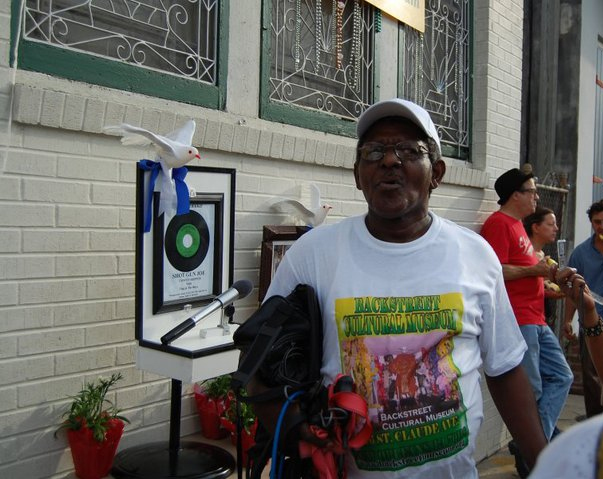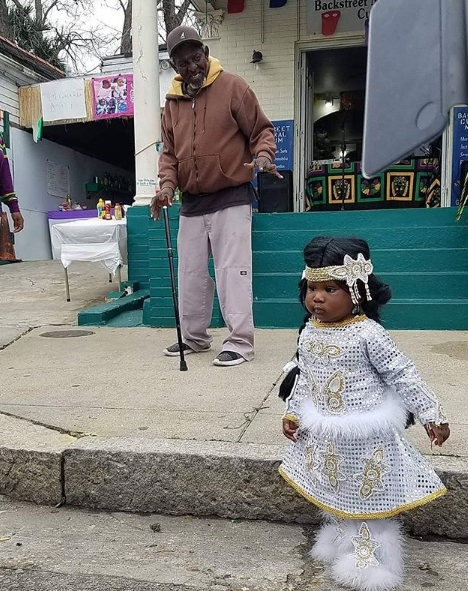“It’s better to be two hours early than two minutes late to a second line,” was one of Sylvester Francis’ oft-repeated jewels of wisdom he offered to visitors from New Orleans and around the word during tours of the Backstreet Cultural Museum that he founded in 1999. Those who ignored his sage advice, which came from a lifetime of deep involvement in this city’s Black street cultures—social aid and pleasure clubs, Mardi Gras Indians and jazz funerals—might very well find themselves trying madly to catch up with the “line.” Sylvester Francis, who died on Tuesday, September 1, 2020, was, like the Museum’s motto states, “A Powerhouse of Knowledge.” He was 73 years old.
A much-beloved and respected member of the New Orleans cultural community, Sylvester Francis’s death inspired a second line on September 1 and a candlelight vigil on September 6.
“A social aid and pleasure club is two things: family-hood and brotherhood,” Francis once noted with insight into the traditions. “The second part is a history or culture that they [members] are really trying to keep going. They’re not trying to keep it going for New Orleans. They are really trying to keep it going for their ancestors so when they look back, they can say ‘My mama did this or my daddy did this.’”
Francis never planned to head a museum and considered himself a cameraman rather than a photographer. Yet his love of this city’s Black street culture directed his destiny. He got his first taste of the traditions when he was around nine years old. He lived in the “back-of-town” area of the 7th Ward, a locale that jumped with activity. Naturally, the scene captivated the youngster especially on Carnival Day when the nearby streets were full of Black Indians including Big Chief Allison “Tootie” Montana and the Yellow Pocahontas that had a stop at a nearby bar on Pauger and Tonti Streets. Skeletons, Baby Dolls and “men who dressed like women” also kept the area lively on the holiday.
Francis vividly recalled the first time he laid eyes on a jazz funeral. “This was a weekday and I see all these people and they’ve got music,” Francis related. “As I got closer, the first thing I saw was a fat, chubby man and he was dancing slow and he was in black. People started telling me it was a jazz funeral. Well it turned out to be the Olympia Brass Band and Fats Houston was the grand marshal. After that day, I started asking everybody about jazz funerals—’Where you find them?’
At first, Francis was involved with the cultures as a “follower” catching as many jazz funerals, Sunday afternoon social aid and pleasure club parades and Black Indian functions as possible.
The year 1979 proved to be pivotal. He put enough money together to parade with the Gentlemen of Leisure Social Aid & Pleasure Club.
“The next day, the parade was gone and I didn’t have a picture,” Francis lamented. “This guy told me he had my picture and he’s selling them for $35. So I bought a picture.” The photo of Francis looking sharp in a light blue outfit hangs in the Museum’s hallway near its entrance.
That same week, a local five-and-dime store was going out of business and offered a movie camera, home projector and screen for $99. Francis bought the package plus a small still camera and soon captured his first jazz funerals, second line parades and Mardi Gras Indian events that gained him his nickname, Hawk, in reference to the Mini Hawk camera he used. Reels of film, many of which have been digitized, from Francis’ early years of shooting fill the Museum’s back room.
 “One of my main goals was—I like this culture so much—that if I was to take anybody’s picture, I’d give them a copy. I think that’s what set the pace for me with Indians and musicians. I feel like the picture is mine but it’s somebody else on the paper.”
“One of my main goals was—I like this culture so much—that if I was to take anybody’s picture, I’d give them a copy. I think that’s what set the pace for me with Indians and musicians. I feel like the picture is mine but it’s somebody else on the paper.”
In 1988, Francis moved to a house on Frenchmen and Rocheblave Streets that boasted a double garage. He began hanging some of his photos in the space as well as Indian pieces—beaded vests, aprons, and the like—given to him by his friend Big Chief Victor Harris, the Spirit of Fi Yi Yi and the Mandingo Warriors. He described the spot as a “little baby museum.” When his brother-in-law died, Francis expected his wife’s relatives, many of whom were active with the Indians, to attend the repast held at their home.
“Knowing they were coming, I put more stuff out,” Francis remembered. When word spread about the display, other Indians offered Francis more accessories as well as entire suits.
Joan Rhodes, of the Rhodes Funeral Home family, with whom Francis had worked, learned of the now-expanding site. She presented tours of the Treme area and asked if she could bring her people to the museum.
“The next day we were bragging on it, but I started saying that nobody else was gonna come here because it’s the back streets,” Francis recalls. “That’s how we came up with the name.”
Francis moved again, lugging, and lovingly providing safe storage for his acquisitions that otherwise might have suffered a less desirable fate. One day, he got a call for Joan Rhodes, who had seen the potential of the little museum. The historic Blandin Funeral Home, which was located in the Treme neighborhood and just a block from the French Quarter and owned by the Rhodes family, had gone out of business. She asked Francis if he wanted the space for his museum. While the offer was a dream come true, Francis was inclined to decline as he just didn’t have any money for such an endeavor.
“She insisted,” Sylvester remembered. “When word got out that I was going to open this museum, a lot of people started calling me up and saying what they had. “I got a suit. I got my grandfather’s this, my brother’s that. I had my head set on Indians and pictures and people started calling saying they had stuff from jazz funerals and second lines—all parts of the black culture. That’s how I got all this—everything’s been donated. I appreciated that to the highest.”
Just like the street traditions it presents, the Backstreet Cultural Museum has been a family, neighborhood and community endeavor. As co-owner, Francis’ wife, Anita “Lu Lu” Francis was active in many aspects of the Museum’s day to day workings including leading tours. During the Backstreet’s annual Mardi Gras street party, she continued to serve up her delicious red beans and rice and cold drinks. Meanwhile Sylvester’s oldest son, “Little Vest” kept the holiday festivities going, spinning classic New Orleans favorites plus lots of Mardi Gras Indian music. The neighborhood guys like Brison, Lucky and Hustler were always on call armed with hammers, staple guns and paint brushes, to be ready for the next repair, project or errand. Brother Robert Francis also helped out with tours and all hands were on deck when the Museum presented its display at the New Orleans Jazz & Heritage Festival. Sylvester never failed to remember the support he got from his much beloved late sister Elvera who often spoke from the Backstreet’s porch during the Museum’s annual All Saint’s Day observance.
Several years ago, Sylvester passed on the directorship of the Museum to his and Anita’s daughter, Dominique Dilling Francis, who previously held the position of co-director. She too has the culture in her blood, having masked Indian with the Fi Yi Yi and Mandingo Warriors for several years. A black and white photo of her great, great grandmother, who masked with the 8th Ward Hunters hangs in the “Indian room” of the museum.
“My goal is to keep the museum open and the tradition going,” says Dominique, whose involvement has greatly expanded in recent years.
A never-to-be-forgotten image of Sylvester Francis, one that showed his love for his family and the Black cultural traditions, was seeing his face bright with pride as he watched his one-and-a-half year old granddaughter, Ador, masked as Indian, jauntily walk out of the Backstreet Cultural Museum and down Henriette Delille Street during last year’s Carnival day.
“Without the kids, it don’t go on,” the always wise, often witty, much-loved and highly respected Sylvester Francis once declared.
In 2003, Sylvester Francis received OffBeat’s Best of the Beat Heartbeat Award for his lifetime of contributing to and preserving the traditions of the local community.
A funeral for Sylvester Francis will be held on Friday, September 11, 2020—his birthday—at the Treme Center. Visitation is from 8 a.m. to 10:45 a.m. followed by a service beginning at 11 a.m. (service requires a wristband). Internment is at St. Louis Cemetery No. 1. A repast will be held from 2 p.m. to 5 p.m. in front of the Backstreet Cultural Museum and across the street in the churchyard next to St. Augustine Catholic Church. A public drive-through viewing will be held from 5 pm to 7 pm on Thursday, September 10 at D.W. Rhodes Funeral Home, 3933 Washington Avenue.
—Geraldine Wyckoff





